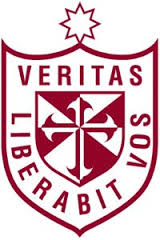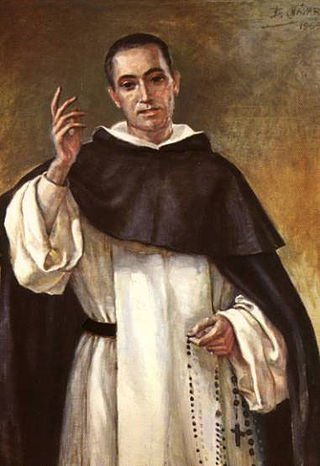
The Order of Preachers, commonly known as the Dominican Order, is a Catholic mendicant order of pontifical right that was founded in France by a Castilian priest named Dominic de Guzmán. It was approved by Pope Honorius III via the papal bull Religiosam vitam on 22 December 1216. Members of the order, who are referred to as Dominicans, generally display the letters OP after their names, standing for Ordinis Praedicatorum, meaning 'of the Order of Preachers'. Membership in the order includes friars, nuns, active sisters, and lay or secular Dominicans. More recently, there have been a growing number of associates of the religious sisters who are unrelated to the tertiaries.

Rose of Lima, TOSD was a member of the Third Order of Saint Dominic in Lima, Peru, Spanish Empire, who became known for both her life of severe penance and her care of the poverty stricken of the city through her own private efforts.

Martín de Porres Velázquez was a Peruvian lay brother of the Dominican Order who was beatified in 1837 by Pope Gregory XVI and canonized in 1962 by Pope John XXIII. He is the patron saint of mixed-race people, barbers, innkeepers, public health workers, all those seeking racial harmony, and animals.

Saint Dominic,, also known as Dominic de Guzmán, was a Castilian Catholic priest and the founder of the Dominican Order. He is the patron saint of astronomers and natural scientists, and he and his order are traditionally credited with spreading and popularizing the rosary. He is alternatively called Dominic of Osma, Dominic of Caleruega, and Domingo Félix de Guzmán, and, in Britain and Ireland, Saint Sunday.

María Ascensión Nicol y Goñi, O.P., was a Spanish Roman Catholic religious sister of the Third Order of St. Dominic. She co-founded and was the first Prioress General of the Congregation of Dominican Missionary Sisters of the Rosary, which she helped to found in Peru.

The Basilica of San Domenico is one of the major churches in Bologna, Italy. The remains of Saint Dominic, founder of the Order of Preachers (Dominicans), are buried inside the exquisite shrine Arca di San Domenico, made by Nicola Pisano and his workshop, Arnolfo di Cambio and with later additions by Niccolò dell'Arca and the young Michelangelo.

The Third Order of Saint Dominic, also referred to as the Lay Fraternities of Saint Dominic or Lay Dominicans since 1972, is a Catholic third order which is part of the Dominican Order.

Carlos Alfonso Azpiroz Costa, O.P. is an Argentinian Catholic friar of the Order of Preachers who has served as the Archbishop of Bahia Blanca since 2015. He was previously his religious order's superior general from 2001 to 2010.

The 17 Thomasian Martyrs were the 12 Dominican priests, 1 Franciscan priest and 3 Dominican bishops who became administrators, professors, or students in the University of Santo Tomas in Manila, they are venerated in the Catholic Church regarded them as a martyrs and declared as a saints and blesseds by several popes throughout the 20th and 21st century, All of them gave up their lives for their Christian faith, some in Japan, others in Vietnam, and in the 20th century, in Spain during the Spanish Civil War. Lorenzo Ruiz de Manila was among the lay companions of the Thomasian Martyrs of Japan, their feast day is celebrated every year on November 6.

The University of San Martin de Porres (USMP) is a private nonprofit university located in the city of Lima, Peru. It was founded by the Dominican Order of the Catholic Church in 1962.
A Religious Brother is a lay member of a religious institute or religious order who commits himself to following Christ in consecrated life of the Church, usually by the vows of poverty, chastity and obedience. Equivalent to a Religious Sister, he usually lives in a religious community and works in a ministry appropriate to his capabilities.

Francisco Coll Guitart, OP was a Spanish Catholic priest of the Order of Preachers and founder of the Dominican Sisters of the Annunciation of the Blessed Virgin.

The Dominican Order was first established in the United States by Edward Fenwick in the early 19th century. The first Dominican institution in the United States was the Province of Saint Joseph, which was established in 1805. Additionally, there have been numerous institutes of Dominican Sisters and Nuns.

Our Lady of the Most Holy Rosary – La Naval de Manila is a venerated title of the Blessed Virgin Mary associated with the same image in the Philippines. Pious believers believe that the Virgin's intercession under this title helped to defeat the invading forces of the Protestant Dutch Republic during the Battles of La Naval de Manila in 1646.

St. Dominic Church is a parish of the Roman Catholic Church, established in 1852. It is located in Southwest Washington, D.C., in the Archdiocese of Washington, and is administered by the Order of Preachers, more commonly known as the Dominicans, in the Province of St. Joseph (Eastern).

The Basilica and Maximus Convent of Nuestra Señora del Rosario, popularly known as the Convent of Santo Domingo, is a Catholic religious complex located in the city of Lima, Peru.

















